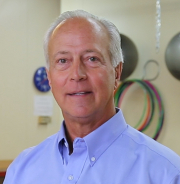Golfers often experience pain at the outer side of their knee on their lead leg with the golf swing. For right handed golfers this would be pain on the outer side of their left knee.
The golfer will often adjust their foot position by toeing out the lead foot to alleviate or decrease their pain. This often can be of benefit but may force the golfer to compensate somewhere else in the body. Secondary stress in another body part can lead to a new injury or the accommodation may demand swing changes that could present another issue.
A common cause of lateral knee pain is a tightening of the iliotibial band. The iliotibial band (tract) arises from the tensor fascia lata and upper fibers of the gluteus maximus and inserts into the lateral aspect of the knee. Repetitively posting and rotating on the lead hip during the golf swing can lead to over stretching of the ITB. Chronic over stretching and friction against the lateral condyle of the femur can cause inflammation of the tendon and pain also known as iliotibial band syndrome.
Other causes of lateral knee pain that are of a secondary nature would be deactivation or weakness of the gluteus maximus which has a fibrous connection to the iliotibial band. If the gluteus maximus cannot perform its function, the iliotibial band will take on more physical stress to attempt to assist it. The gluteus medius is responsible for lateral stabilization of the hip. If the gluteus medius and tensor fascia lata are not capable of stabilizing the lead hip when the golfer posts and rotates on it, the iliotibial band has to take on the responsibility of stability and cannot handle it. This excess stress leads to tightening of the ITB and inflammation.
Foot mechanics plays a big part in iliotibial tract function. If the golfer has poor foot support in the lead foot the iliotibial band can tighten. Extrinsic lack of support from the golf shoe either allowing the foot to over pronate or supinate will create additional tension and stress on the ITB. Intrinsic foot dysfunction from poor foot mechanics, particularly flat feet, will allow for excess medial tibial rotation. Secondary dysfunction can occur in the ITB and lead to an inflammatory response. Extrinsic and intrinsic causes of foot dysfunction must be considered since they often directly effect lower leg mechanics and put stress on the iliotibial tract.
Posture must always be assessed with lateral knee pain. Pelvic tilt and lower extremity alignment directly affect knee pain. Anterior pelvic tilt, a short leg, and genu varum (bow-leggedness) are the more common postural findings that correlate with lateral knee pain. When checking body alignment, always be aware that fibular head restriction and popliteus strain can cause lateral knee pain. These conditions are also most noticeable in the lead leg due to the posting and torsion on the lead knee.
Less evident but equally significant is the non-firing of the multifidii. Lumbopelvic muscles involved with stability will assist one another in their similar basic function. If the multifidii are not capable of doing their job as spinal stabilizers, muscles in the hips that work to provide stability will take on more demand.
The golfer has to be aware of all of the factors that may cause lateral knee pain. Once addressed the condition can be resolved and not disrupt or present a challenge to swing mechanics. Not addressing all factors can predispose the golfer to reinjury or compensatory stresses that could create new problems.

